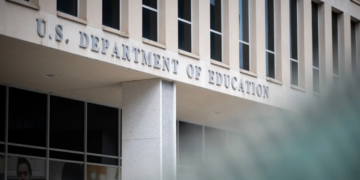Oct 6, 2024 Story by: Editor
On the morning of April 18, 2013, in Buena Park, a suburb of Los Angeles, photographers gathered as two police officers entered a townhouse. Shortly after, they emerged with a weary woman in pajamas and handcuffs, triggering a frenzy of camera clicks.
“You would swear I had killed somebody,” the woman, Cheree Peoples, recalled in a recent interview.
Peoples had been arrested due to her daughter’s poor school attendance, falling afoul of a truancy law championed by then-California Attorney General Kamala Harris. The law, enacted in January 2011, made it a criminal misdemeanor for parents to allow children in kindergarten through eighth grade to miss over 10% of school days without a valid excuse. Peoples’ 11-year-old daughter, Shayla, had already missed 20 days that school year.
Harris had spent years campaigning for a tougher stance on truancy, viewing it as essential to reducing crime. As San Francisco’s district attorney in the mid-2000s, Harris had noted that a disproportionate number of homicide victims were high school dropouts, and truancy was a risk factor for later criminal involvement. Her efforts led to prosecutions of parents whose elementary-aged children were missing school, and eventually, harsher penalties for truancy across California. The law passed just as Harris won her attorney general election.
“We are putting parents on notice,” Harris said at her 2011 inauguration. “If you fail in your responsibility to your kids, we are going to work to make sure you face the full force and consequences of the law.”
Peoples was one of six parents arrested that day in Orange County, in front of media outlets, as part of an effort to prevent future crime and gang involvement. The district attorney’s office criticized Peoples, stating that despite offers of counseling and parenting classes, she ignored numerous warnings and meetings.
“The defendant was offered counseling and parenting classes,” read a statement from the district attorney’s office. “The student was provided the opportunity for a mentor through Big Brothers Big Sisters of Orange County, a mentor at school [and] monthly meetings with law enforcement officers.”
Days after her arrest, Peoples, who had spent much of her life caring for Shayla due to her daughter’s sickle cell anemia, found herself in disbelief. Shayla’s medical condition often kept her from attending school, and the school had records from a children’s hospital outlining the unpredictability of her absences. Peoples claimed she had been advocating for additional accommodations for her daughter, which the school had denied.
“This is a young woman who spends a lot of her life in the hospital,” Peoples said. “How is it that she’s giving off the impression of being a gang member? … Why are they coming after me?”
Peoples’ arrest was a direct result of Harris’ tough stance on truancy, a campaign that reshaped the way California approached the issue. Though Harris later softened her position, arguing that parents of truant children needed support rather than punishment, the consequences of her earlier policies remained. Hundreds of families across California still faced legal repercussions under Harris’ law.
Jeff Adachi, San Francisco’s chief public defender, acknowledged the importance of addressing truancy but criticized Harris’ methods. “There is a correlation between children who fail at school and what happens later in life. [But] the idea of locking parents up, or citing them with a crime because they’re not taking their children to school — it doesn’t address the root of the problem,” he told HuffPost.
Adachi pointed out that Harris’ approach reflected the limitations of progressive prosecution. “You can have some influence. But it’s a system because the people in power act according to the design. And if you’re a prosecutor, your job is to charge people with crimes,” he explained in an interview with KQED.
Harris was not the first to push for jail time for truancy. Many states have compulsory attendance laws, and parents, as well as children, have been incarcerated for truancy-related offenses. California’s laws regarding truancy have been in place since at least 1977, though the severity of the penalties escalated with Harris’ involvement.
Hedy Chang, executive director of Attendance Works, a nonprofit organization focused on improving school attendance, explained the importance of addressing truancy. Regular school attendance, she noted, is essential for a child’s development, especially for those from lower-income families. Missing more than 10% of school time puts children at a higher risk of falling behind academically and eventually dropping out. Chang emphasized that while punitive approaches may not be the answer, preventative measures, like outreach to parents and addressing systemic barriers, have proven more effective.
“A punitive legal approach, I just haven’t seen evidence that shows that works,” Chang said.
Truancy, as defined by law, often varies, with schools having discretion over what constitutes a valid absence. This ambiguity, Chang pointed out, often results in biases, particularly affecting students of color, who are disproportionately deemed truant. Harris highlighted the link between early childhood truancy and negative life outcomes, describing it as “like tiptoeing over the sizzling fuse on a time bomb” in her 2009 book Smart On Crime.
In her early days as district attorney, Harris had her office send letters to parents, warning them of the criminal consequences of truancy. Prosecutors attended school meetings with parents, reinforcing the gravity of the situation. While some community activists found her approach heavy-handed, others believed her actions were driven by a desire to address the root causes of truancy.
“The thing about Kamala that I saw on every issue I worked with her on, she is always asking, ‘What are the root causes of the problem?‘” said Jill Habig, a former advisor to Harris. “She really rejected the notion that all a prosecutor should do is focus on charging people with crimes and putting people in jail.”
Harris remained unfazed by the criticisms directed at her approach. In 2008, she charged six parents with infractions using a newly established truancy court that implemented special procedures. The judge decided to defer any punishments as long as families started adhering to the law. “The goal was not to get them into trouble but to find a way to exert enough pressure on them that they would change,” stated David Kopperud, the longtime chair of California’s statewide student attendance review board.
As a result, San Francisco’s truancy rate began to decrease. In a speech delivered a few years later, Harris attributed this success to her stringent tactics, asserting, “We threatened the parents of truants with prosecution, and truancy dropped 32 percent.”
What set Harris’s approach apart was not just the process but also the timing and the players involved. She utilized a standard method — where the school identifies a truant student, contacts the parents, and holds a meeting if necessary, then refers the issue to the district attorney if needed — that counties across California had been employing for decades. Harris innovated by ensuring that school authorities and the district attorney worked together, communicating the threat of prosecution much earlier and keeping school officials engaged long after a case moved to court.
“It was using the law to support what the school was doing, and vice versa,” Kopperud remarked. “And she had a lot of success.”
Limitations
After being elected California attorney general in 2010, Harris quickly aimed to expand her model statewide. Her office began to highlight counties with alarming truancy rates and the significant financial costs associated with them. Since a school’s average daily attendance affects its state funding, frequent absences lead to monetary losses. She emphasized best practices and offered extensive recommendations for improving attendance, using considerably softer language than she had in public.
“Early intervention by law enforcement should be supportive, not punitive,” the first report asserted. To strengthen local attendance review boards, which are positioned between individual schools and county courts, she mandated the inclusion of a representative from the district attorney’s office, and after some backlash, from the public defender’s office as well.
However, her most notable victory stirred considerable notice and controversy: In 2011, at Harris’s urging, California established its first-ever criminal penalties for parents of truant children. Before this, having a truant child was merely an infraction punishable by a small fine. The new law allowed parents to be charged with a misdemeanor and face a minimum fine of $2,000 or up to one year in jail. A child was classified as truant if they missed 10% or more of school days without a valid excuse, and the school district had attempted a designated number of interventions. Similar to her San Francisco trial, the law permitted the court to defer judgment if the parent agreed to a mediation period and improved their situation.
By this point, many believed that the San Francisco model had evident limitations. Parents were not being jailed or fined on a large scale, contrary to activists’ initial fears. Yet, critics contended that the language Harris used to promote a crackdown on truancy and the system she reinvigorated reinforced the notion that parents were always the primary source of the issue.
A public defender who represented parents in San Francisco’s truancy court for many years noted that most families involved were grappling with situations largely beyond their control, such as violence at school or a lack of accommodations for chronic illnesses. If a family was not responding to the school, it was typically because they were facing larger crises related to poverty. Nearly all the parents under scrutiny were Black or Latino.
“What it ended up being, practically, is families and kids having to come to court to be told to utilize certain services in order to come to school,” said the public defender, who requested anonymity due to her ongoing work in juvenile justice. “Which, from where I sit, is very much the job of the school district and not the job of the criminal court.”
The system was not designed to address the more significant challenges facing the parents. “Their idea was, you’re not going to school, and — whether or not what the school district is doing is sufficient to get you to school — we have this mechanism to cite you,” the public defender remarked.
I posed some of these criticisms to Katy Miller, a prosecutor in the San Francisco District Attorney’s office who has worked on truancy issues since Harris’s time.
“I ask myself those same questions, and I think [Harris] did as well: At the end of the day, what is the solution in these cases where we feel like everything has been offered and the dynamic hasn’t changed?” she said. “Are we just going to let it be? It’s a hard question, I think we should be very parsimonious as prosecutors.” In San Francisco, Miller noted that the district attorney only brings parents to court if their kids have missed 40, 60, or even 80 days of school.
Habig defended Harris, pointing out that as attorney general, she established a new agency called the Bureau of Children’s Justice to investigate and address systemic barriers to education; the intention was to hold the education system accountable, not solely the parents.
As attorney general, however, Harris had limited power over whether local prosecutors implemented her law’s intended spirit. Some counties that had historically adopted a punitive approach reserved the new penalties for the most egregious cases. Each year, Kings County, located in the Central Valley, charges hundreds of parents under California’s older laws, but only 19 misdemeanors under Harris’s law in the past four years, with at least two mothers sentenced to jail. In Tulare County, also in the Central Valley, there have been 14 cases, and officials there take pride in their efforts. A brochure from a 2016 student attendance conference praised the county’s attendance supervisor for “successfully submitting” three truancy cases under Harris’s new law, in addition to over 500 cases charged under California’s older laws.
Orange County, where Peoples was arrested, has charged a total of 22 parents under Harris’s law. The district attorney’s office, Shayla’s elementary school, and the Buena Park School District all declined to comment on Peoples’ case or the decision-making process for prosecutions. Tony Rackauckus, who served as the district attorney during Peoples’ arrest and left office this January, also refrained from answering questions but expressed that he was “extremely proud” of his office’s anti-gang initiatives, including truancy enforcement. (Almost all truancy prosecutions under Rackauckus took place in the 18 months leading up to one of his re-election campaigns; it remains unclear if this is a coincidence.)
San Francisco — Harris’s former district — has not charged any parents under the new law. Prosecutors there have determined that a punitive approach is unnecessary, Miller explained.
The Bully Pulpit
Evaluating Harris’s legacy presents challenges. She was not the only advocate for new truancy policies and, notably, did not achieve all her goals. Then-Gov. Jerry Brown (D), emphasizing the importance of preserving local autonomy, vetoed a measure that would have mandated all 58 counties to follow a standardized truancy process, as well as a bill to monitor the number of truancy prosecutions conducted under Harris’s law. Consequently, the state remains unaware of how many parents have been arrested, arraigned, or prosecuted under Harris’s criminal truancy statute, according to Kopperud.
For all its investment in combating chronic absenteeism, California cannot definitively determine whether class attendance has improved or declined over the past decade. The state struggles to make a clear comparison due to multiple changes in data collection methods, Kopperud noted.
Nonetheless, few dispute that Harris made a significant impact.
“She was able to use her office as a bully pulpit for the understanding that chronic absence and truancy were both major issues, to help people grasp the scope and scale and the value of taking a positive, problem-solving approach,” stated Chang, the executive director of Attendance Works. This approach proved more influential than simply imposing new criminal penalties, she added.
Harris’s rhetoric from that bully pulpit has shifted over the years. When serving as San Francisco’s district attorney, she emphasized the need for “getting tough on truancy” and labeled truancy as “a parent issue” stemming from “neglect.” If her prosecutors identified that the parents they were prosecuting faced difficult circumstances, she often framed it as a side note to the larger issue of inadequate parenting.
“Along the way, we learned some things about the situations some of these families faced and found we could help,” she wrote in Smart On Crime. “For example, we met a mother with three children who were homeless and holding down two jobs trying to get her situation under control.” Harris’s office assisted her in securing housing.
A decade later, Harris would assert that the entire objective was to connect parents with the necessary resources. (Her campaign declined to request an interview.)
“[Critics] assume that my motivation was to lock up parents when of course that was never the goal,” she wrote in her 2019 memoir, The Truths We Hold. “Our effort was designed to connect parents to resources that could help them get their kids back into school, where they belonged. We were trying to support parents, not punish them—and in the vast majority of cases, we succeeded.”
Her narrative has evolved enough that I was curious to see which version is applicable in California today. In February, I visited Humboldt County, in northern California, to observe a monthly session of the county’s student attendance court. Outside, a historic downpour raged, yet Judge Joyce Hinrich’s voice was cheerful as she informed the damp crowd of parents and students that her court focused on behavior modification rather than punishment. She assured them there would be no fines or jail time, provided that the student’s attendance improved.
“The goal here is to get everyone back on track,” she said, noting that attendance had increased since the court’s establishment. “I know I’ve been saying this, but we’re not here to punish you.”
She then presented attendance certificates to a few kids, and a handful of parents cheered. Source: HUFF POST

















